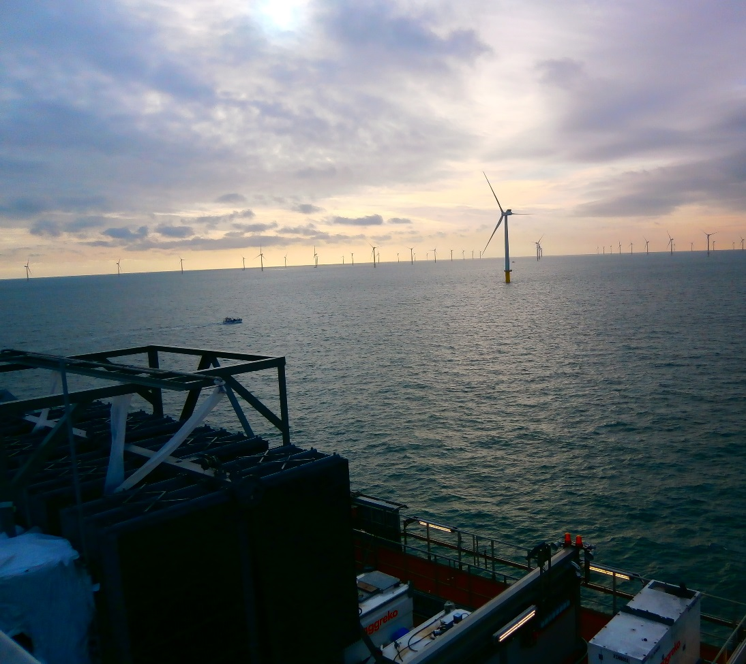In Linxon, we believe in the importance of sustainability, which is why we strive to offer the best service to our clients, always under the most demanding quality, safety and environmental protection requirements.
Just as nature enabled our evolution as a species, it also permits our survival and wellbeing today. For example, while half of the world’s oxygen is produced through phytoplankton photosynthesis in the sea, the other half is produced through photosynthesis on firm ground by trees, shrubs, grasses and other plants. Yet, despite all the vital benefits that nature offers us, we mistreat it constantly and in multiple ways.
Today we commemorate World Environment Day with biodiversity as main topic, a matter of both urgent and existential concern.
Everything we are comes from biodiversity
Biodiversity encompasses approximately 8 million species on the planet, and the ecosystems that host them need them to maintain vital ecological processes. The diversity of ecosystems also allows for a great diversity of species to develop, closing the loop.
Biodiversity and ecosystems produce a wide range of benefits on which people depend: from fishing, crops and timber, to the least obvious, like how corals protect the coasts from hurricanes. These benefits are often called ‘ecosystem services’, some of which, like food, are more easily quantified than others, such as climate regulation or cultural values. However, changes in many of these services are often not obvious to those who depend on them. Even with well-documented ecosystem impacts, it is difficult to quantify human vulnerability that results from shifts in ecosystem processes and services.
The price of inaction
In the last decade, the great biodiversity of the planet had a significant reduction. Some species disappeared as victims of climate change, habitat loss, overexploitation, among others. Meanwhile, more than one million of them are in serious danger of extinction.
Even the current COVID-19 pandemic, the latest in a series of ‘zoonotic disease’ outbreaks (meaning diseases that can be transmitted between animals and humans) shows that the environment health is closely linked to our health. Either because we have been exposed to new pathogens as a result of the destruction of natural environments and subsequent appropriation of the territory, and/or the embarrassing hunting of wild or exotic species for mere recreational reasons (exotic meals, naive pharmacopeia, etc.), the current global crisis is very related to biodiversity loss.
What we often forget is that if vital processes in ecosystems were to become extinct, our very existence would be endangered.
Land-use change
The loss and deterioration of habitats is historically one of the main causes of loss of biodiversity. Our demand for food and resources is driving deforestation, changing patterns of land use, and destroying natural habitats across the globe.
To date, half of all habitable land is used for agriculture and livestock accounts for 77% of global farming land. What is more, one-third of the world’s topsoil has been degraded from acidification, pollution and other unsustainable land management practices.
Overexploitation of plants and animals
Overexploitation is the extraction of individuals from a population at a higher rate than their reproduction. When this happens, the population inevitably decreases.
Overexploitation has been the fate of many of the species that have been exploited for different reasons, like whales or orchids. In fact, many of them are currently still endangered for the same reasons. Some species are more vulnerable than others due to their biological characteristics such as restricted geographic distribution, low abundance, high mortality rate, low reproductive rate, high congregation of the population, among others.
Pollution
The increase in the presence of man-made chemicals in the environment as a result of human activities has serious consequences for many species. Industrial, agricultural, livestock and urban activities, contribute substantially to air, water and soil contamination. Some of these pollutants have weakened the ozone layer that protects living things from ultraviolet radiation from the Sun, while others have highly contributed to global warming.
Currently, water, soil and air pollution directly affect many organisms even in remote places. Excess energy such as sound, heat or light is also considered a pollutant, as well as transgenic organisms. Moreover, open waste dumps impact plants and animals, while pesticides, fertilisers and other chemicals harm pollinators like bees and bats, which are natural predators of pests.
Other big problem is our waste disposal. The world now produces an average of 2.1 billion tonnes of trash each year including solid waste, plastics, food, and hazardous waste –enough to fill more than 820,000 Olympic-size swimming pools. However, only 16% (323 million tonnes) of this amount is recycled each year, while 46% (950 million tonnes) is ‘disposed unsustainably’.
Similarly, the G20 countries account for 74% of current global greenhouse gas emissions. In 2015, the average annual emissions in these countries were approximately 7 to 8 tonnes of CO2 equivalent (tCO2e) per capita. Most of these are due to burning fossil fuels to produce energy. If we want to reach the 2°C global temperature target, global emissions should fall by an average of 1 to 3 tCO2e per capita by 2050. Unfortunately, a more recent OECD report reveals that its member countries (37 in total) currently emit an average of 9 tCO2e per capita, compared to 4 tonnes on average in the rest of the countries.
Climate emergency
During the past 100 years, the increase in the average temperature of the planet’s atmosphere and oceans has been documented and correlated to the increase in the concentration of greenhouse gases (CO2, methane, oxides of nitrogen, ozone, chlorofluorocarbons and steam water) produced by burning fossil fuels and deforestation, a combination of excess production and reduced capacity to capture pollution.
The consequences are radical changes in the distribution of ecosystems and species, rising sea levels, disappearing glaciers and large sections of coral, and contributing with unpredictable extreme climates. Climate change affects all organisms on the planet, many of them are already responding to this new dynamic through changes in their geographic distribution and migrations. By 2050, it is estimated that one in six species could be threatened with extinction if current warming trends continue.
A future committed to the protection of diversity
Sustainability is a shared responsibility in which everyone –governments, citizens and organisations– must do their bit for the conservation of natural resources in the long term. We owe it to our planet and to future generations.
At Linxon, we consider it our responsibility to improve environmental performance in each of our activities and projects, maintaining our high standards of quality, occupational health and safety. We support our clients in creating stronger, smarter and greener networks that are tailored to meet the changing needs of an evolving energy landscape. To do this, we offer solutions that facilitate the integration and interconnection of cleaner energy supplies and that help maintaining network reliability and secure energy supplies.
Renewable generation
For renewable power systems, Linxon solutions enhance the capacity, reliability and availability of transmission and distribution networks with proven substation designs and innovative grid technologies. For example, we are contributing to the connection of several wind parks through a turnkey upgrade for an electrical substation.
Beyond their low emission of polluting gases, these projects do not require fossil fuel extraction activities or an excessive use of natural resources for their operation. They also don’t create difficult-to-solve waste problems, making them highly environmentally friendly offers.
Transport
For rail substation applications and mass transit transmission, we offer optimised rail electrification solutions ensure that reliable AC and DC power supplies are available to support high performance and efficiency. Our transport projects contribute to reducing greenhouse gases (CO2) and fine particles, as well as facilitating more urban space and the organisation of smarter cities where displacement is minimised.
(Read more about our Quality and Sustainability principles by clicking here).
Protection of local biodiversity
We encourage and celebrate all kinds of additional measures to protect our environment. To illustrate this, we participate in a project in the UK that has considered reforestation activities, minimisation of the habitat destruction impact studies, relocation of local species, among others.
Furthermore, a Linxon volunteering team in the same region created a green space within one of our construction sites that, among its many benefits, contributes to avoid the decrease in diversity and abundance of bees, whose existence is very important for British ecosystems.
Biodiversity loss and COVID-19
The context of this year is different due to the COVID-19 pandemic and its visible effects on nature and cities around the world. While many of us are currently in confinement, there are thousands of closed companies worldwide, vehicle restrictions and sparsely populated streets. But not everything is bad. Quarantining the new coronavirus leaves humanity with several lessons. Two excellent examples are from China and India.
China reduced by more than a quarter its pollution thanks to low CO2 emissions until February of this year, as the country slowed its production rate due to the impact of the pandemic. Likewise, according to reports from the Central Pollution Board of India, the lockdown improved air quality and low levels of PM 2.5 and of nitrogen dioxide (NO2) were recorded.
Like these two countries, we have noticed the great positive changes produced in the environment around the world. An opportunity that we should certainly take advantage of and try to maintain in the future.
May this World Environment Day inspire everyone to make their voices heard — citizens need to urge their governments and themselves to deliver on their commitments to safeguard nature, end pollution and ensure that environmental laws are upheld. Companies must develop sustainable strategies, as well as agricultural and manufacturing practices that do not harm the environment. Likewise, all societal groups should look at how to preserve and restore degraded ecosystems. This includes practices such as rethinking what we should buy as customers, managing our waste in a more environment-friendly way and reducing our individual and collective carbon footprint.
With our lives upended, we can unite to find ways not only to live well in harmony with each other, but also with nature.
References:
Cheng, Vincent C. C., o.a. ”Severe Acute Respiratory Syndrome Coronavirus as an Agent of Emerging and Reemerging Infection.” American Society for Microbiology (2007): 660-694.
Climate Transparency. G20 Emissions. 06 11 2015. https://www.climate-transparency.org/g20-emissions.
Intergovernmental Science-Policy Platform on Biodiversity and Ecosystem Services. Models of drivers of biodiversity and ecosystem change. n.d. https://ipbes.net/models-drivers-biodiversity-ecosystem-change.
International Union for Conservation of Nature. “IUCN Red List.” 2019. https://www.iucnredlist.org/search?permalink=c7fb1f9f-96fa-4875-8e15-a335a71f4b97.
National Climate Assessment. Ecosystems and Biodiversity. Pennsylvania Avenue, NW; Washington, DC: U.S. Global Change Research Program, 2014. https://nca2014.globalchange.gov/report#intro-section.
Nichols, Will and Niall Smith. “Waste Generation and Recycling Indices 2019: Overview and findings.” 2019. https://www.circularonline.co.uk/wp-content/uploads/2019/07/Verisk_Maplecroft_Waste_Generation_Index_Overview_2019.pdf.
OECD. Environment at a Glance 2020. Paris: OECD, 2020.
Resnick, Brian. The species the world lost this decade. 09 12 2019. https://www.vox.com/energy-and-environment/2019/12/9/20993619/biodiversity-crisis-extinction.
Ritchie, Hannah. Half of the world’s habitable land is used for agriculture. 11 11 2019. https://ourworldindata.org/global-land-for-agriculture.
Roach, John. “Source of Half Earth’s Oxygen Gets Little Credit.” National Geographic 07 06 2004. https://www.nationalgeographic.com/news/2004/6/source-of-half-earth-s-oxygen-gets-little-credit/.
Smith, Niall. US tops list of countries fuelling the waste crisis. Waste Generation and Recycling Indices. 02 07 2019. https://www.maplecroft.com/insights/analysis/us-tops-list-of-countries-fuelling-the-mounting-waste-crisis/.
United Nations Environment Program. GEO-6: Global Environment Outlook. [online]: United Nations, 2019. https://wedocs.unep.org/bitstream/handle/20.500.11822/27539/GEO6_2019.pdf?sequence=1&isAllowed=y.
World Health Organization – Regional Office for the Eastern Mediterranean. Zoonotic disease: emerging public health threats in the Region. n.d. http://www.emro.who.int/about-who/rc61/zoonotic-diseases.html.





